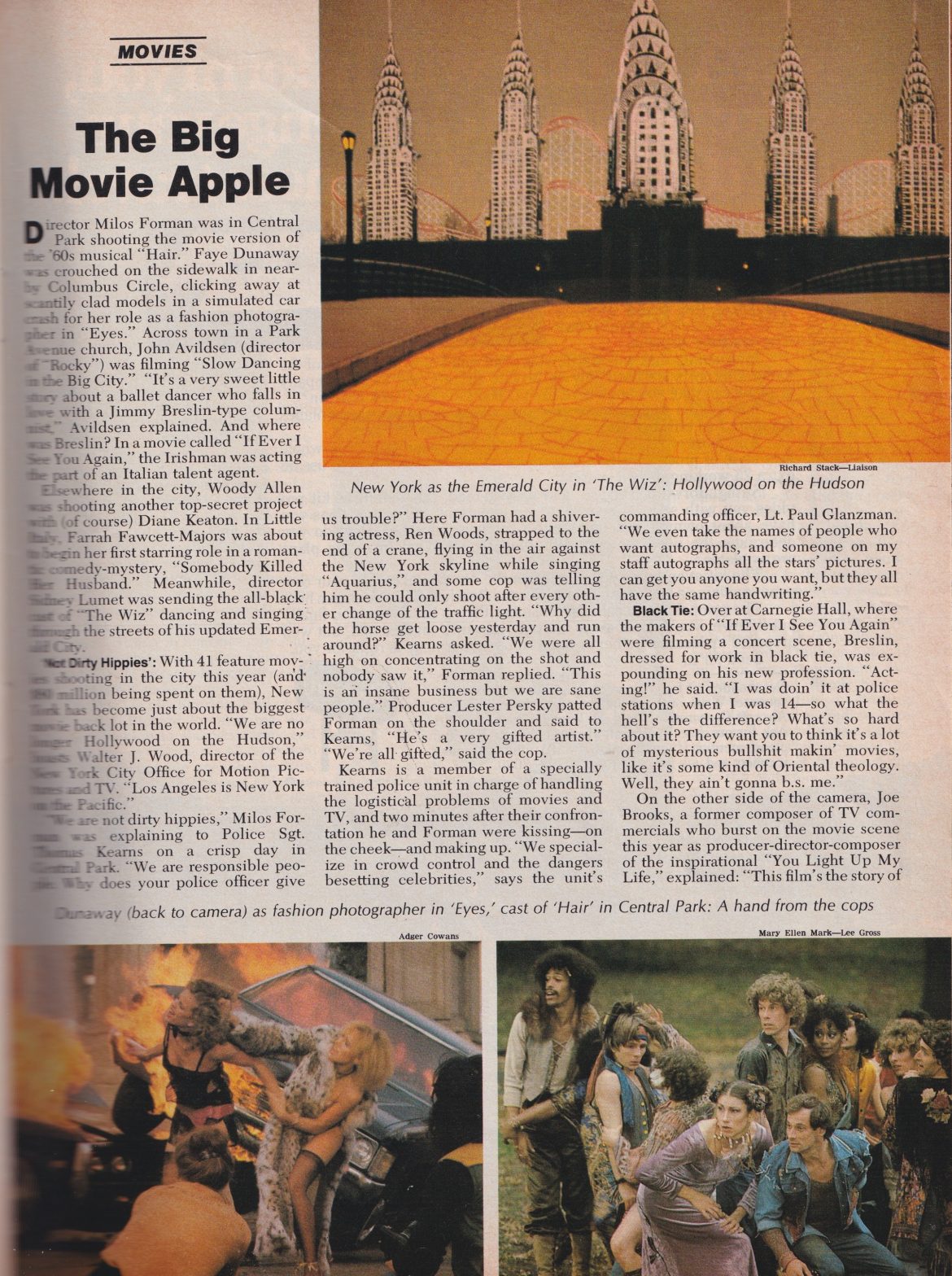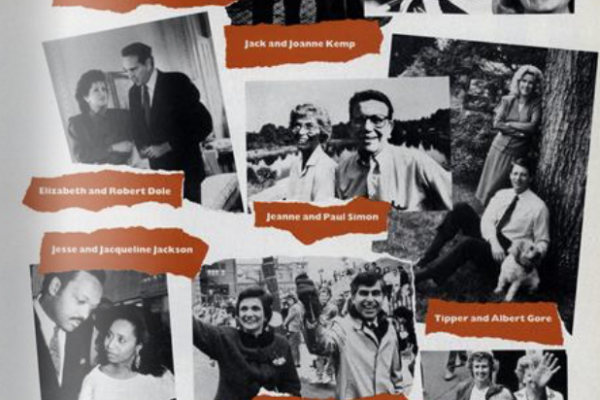Original Publication: Newsweek – December 12, 1977
Director Milos Forman was in Central Park shooting the movie version of the ‘60s musical “Hair.” Faye Dunaway was crouched on the sidewalk in nearby Columbus Circle, clicking away at scantily clad models in a simulated car crash for her role as a fashion photographer in “Eyes.” Across town in a Park Avenue church, John Avildsen (director of “Rocky”) was filming “Slow Dancing in the Big City.” “It’s a very sweet little story about a ballet dancer who falls in love with a Jimmy Breslin-type columnist,” Avildsen explained. And where was Breslin? In a movie called “If Ever I See You Again,” the Irishman was acting the part of an Italian talent agent.
Elsewhere in the city, Woody Allen was shooting another top-secret project with (of course) Diane Keaton. In Little Italy, Farrah Fawcett-Majors was about to begin her first starring role in a romantic comedy-mystery, “Somebody Killed Her Husband.” Meanwhile, director Sidney Lumet was sending the all-black cast of “The Wiz” dancing and singing through the streets of his updated Emerald City.
‘Not Dirty Hippies’: With 41 feature movies shooting in the city this year (and $80 million being spent on them), New York has become just about the biggest movie back lot in the world. “We are no longer Hollywood on the Hudson,” boasts Walter J. Wood, director of the New York City Office for Motion Pictures and TV. “Los Angeles is New York on the Pacific.”
“We are not dirty hippies,” Milos Forman was explaining to Police Sgt. Thomas Kearns on a crisp day in Central Park. “We are responsible people. Why does your police officer give us trouble?” Here Forman had a shivering actress, Ren Woods, strapped to the end of a crane, flying in the air against the New York skyline while singing “Aquarius,” and some cop was telling him he could only shoot after every other change of the traffic light. “Why did the horse get loose yesterday and run around?” Kearns asked. “We were all high on concentrating on the shot and nobody saw it,” Forman replied. “This is an insane business but we are sane people.” Producer Lester Persky patted Forman on the shoulder and said to Kearns, “He’s a very gifted artist.” “We’re all gifted,” said the cop.
Kearns is a member of a specially trained police unit in charge of handling the logistical problems of movies and TV, and two minutes after their confrontation he and Forman were kissing – on the cheek – and making up. “We specialize in crowd control and the dangers besetting celebrities,” says the unit’s commanding officer, Lt. Paul Glanzman. “We even take the names of people who want autographs, and someone on my staff autographs all the stars’ pictures. I can get you anyone you want, but they all have the same handwriting.”
Black Tie: Over at Carnegie Hall, where the makers of “If Ever I See You Again” were filming a concert scene, Breslin, dressed for work in black tie was expounding on his new profession. “Acting!” he said. “I was doin’ it at police stations when I was 14 – so what’s the hell’s the difference? What’s so hard about it? They want you to think it’s a lot of mysterious bullshit makin’ movies, like it’s some kind of Oriental theology. Well, they ain’t going to b.s. me.”
On the other side of the camera, Joe Brooks, a former composer of TV commercials who burst on the movie scene this year as producer-director-composer of the inspirational “You Light Up My Life,” explained: “This film’s the story of a successful commercial-jingles composer who goes to California to find the girl he left behind at 18. I’m the producer, the director and the star.” Does he get the girl? “I don’t believe in paying money and not seeing a happy ending.”
Breslin was very annoyed at Barra Grant, the 29-year-old daughter of Bess Myerson whose first script is the basis for “Slow Dancing in the Big City.” “Who do you think Paul Sorvino looks like?” he asked about the actor who plays the tough-soft columnist in the film. Over in the Park Avenue church, Grant was unfazed: I want to direct and act and produce and write. I want to be a Renaissance woman and grow petunias.” Director Avildsen discussed his future projects. “I’m next going to do a film about sex surrogates. Them I’m going to England to make ‘Robin Hood’.”
‘Instinct and Energy’: Jon Peters, the producer of “Eyes,” was feeling even more ambitious. “I want to do 9 million haircuts and 62 movies,” said the former hairdresser, 32, who turned producer after he began living with Barbra Streisand. So far on “Eyes,” he’s used four writers and is rumored to have fought tooth-and-nail with his star, Faye Dunaway. “Are you kidding?” he said. “We fight like crazy until we get what’s really right and do it. It’s the same with me and Barbra. We’re so competitive. I tell her, ‘Why compete with me? I’m just starting out.’ This movie is to me what ‘Shampoo’ was to Warren Beatty. If I make any mistakes they won’t grow out.” Sitting in her trailer dressing room on an abandoned pier, Dunaway purred: “What he lacks in experience he has in instinct and energy.”
“The Wiz” is big. Starring Diana Ross as Dorothy, Richard Pryor as the Wiz, Michael Jackson as the Scarecrow and Lena Horne as Glinda the Good With, it’s the biggest movie ever shot in New York. Produced by the 28-year-old wunderkind Rob Cohen (“Mahogany”), it is costing $15 million-plus and involves, among other spectacles, 20 miles of yellow Congoleum, a production number with 400 dancers in costumes created by eleven top New York designers, and 6 million watts of electricity requiring 80 miles of cables. It is billed as director Sidney Lumet’s “Valentine to New York.”
Yellow Brick Road: On a recent evening, Lumet and “The Wiz” gang were assembled in a Manhattan subway station. The station’s platform had been paved entirely in the yellow vinyl, its pillars turned into the ominous crushing machines and the turnstile transformed into a buzz saw in which Diana Ross was on the verge of being hacked to pieces (only to be saved by the Lion). As Ross in Dorothy’s magic slippers was approaching the treacherous turnstile, a member of the crew shrugged: “New Yorkers. We put this stuff down at the height of rush hour. They stopped to ask what we were doing. I told them we were laying the Yellow Brick Road, and they said, ‘Oh’.”
This article is typed from the original material. Please excuse any errors that have escaped final proofreading.


